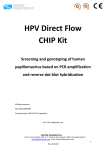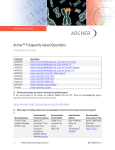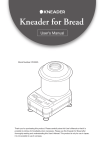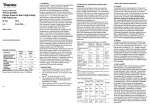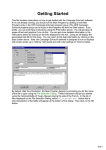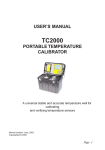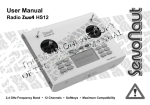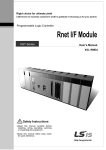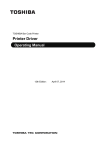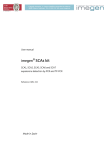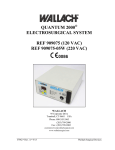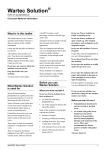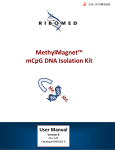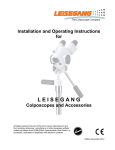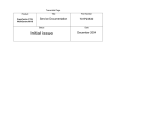Download HPV Direct Flow CHIP Kit
Transcript
HPV Direct Flow CHIP Kit Screening and genotyping of human papillomavirus based on PCR amplification and reverse dot blot hybridization to be used with hybriSpot 12™ (HS12) / hybriSpot 24™ (HS24) For in vitro diagnostic use 48 determinations Ref. MAD-003930M-HS48 Produced under UNE-EN 375 regulations MASTER DIAGNÓSTICA Avda. Conocimiento 100. P.T. Ciencias de la Salud; 18016-Granada (Spain) [email protected] www.masterdiagnostica.com 1 Rev: 2014-09 TABLE OF CONTENTS 1. INTENTED USE ........................................................................................................................... 3 2. TEST PRINCIPLE ......................................................................................................................... 3 3. REAGENTS INCLUDED IN THE KIT ............................................................................................. 4 4. STORAGE AND STABILITY ......................................................................................................... 4 5. EQUIPMENT AND MATERIALS REQUIRED BUT NOT SUPPLIED IN THE KIT ............................. 5 6. REMARKS AND PRECAUTIONS ................................................................................................. 5 7. OPERATING PROCEDURE .......................................................................................................... 6 7.1. REAGENTS PREPARATION ..................................................................................................... 6 7.2. SAMPLE PREPARATION FOR DIRECT PCR.............................................................................. 6 7.3. PCR REACTION ....................................................................................................................... 8 7.4. AUTOMATIC FLOW-THROUGH REVERSE HYBRIDIZATION ................................................... 8 8. INTERPRETATION OF THE RESULTS .......................................................................................... 9 9. REPRODUCIBILITY OF HPV Direct Flow CHIP ......................................................................... 10 10. ANALYTICAL SENSITIVITY AND SPECIFICITY OF THE HPV Direct Flow CHIP ........................ 11 11. TROUBLESHOOTING ............................................................................................................. 11 12. BIBLIOGRAPHY ...................................................................................................................... 11 MASTER DIAGNÓSTICA Avda. Conocimiento 100. P.T. Ciencias de la Salud; 18016-Granada (Spain) [email protected] www.masterdiagnostica.com 2 Rev: 2014-09 1. INTENTED USE HPV Direct Flow CHIP is a diagnostic kit for in vitro detection of human papillomaviruses (HPV). HPV detection has become a very important tool in diagnostic because infection with these viruses constitutes an essential factor for cervical and anogenital carcinogenesis (zur Hausen et al, 1974; Walboomer et al, 1999; zur Hausen, 1996; zur Hausen 2002). 2. TEST PRINCIPLE Based on their association with different lesion grades, HPV have been classified as (Muñoz 2003) high risk HPVs or oncogenic, that can induce carcinogenesis; and low risk HPVs, that cause genital warts and collaborate with high risk HPVs. HPV Direct Flow CHIP is intended for simultaneous screening and genotyping of 18 high risk genotypes (HPV 16, 18, 26, 31, 33, 35, 39, 45, 51, 52, 53, 56, 58, 59, 66, 68, 73 and 82-, and 2 low risk (HPV 6 and 11) by PCR (polymerase chain reaction), followed by reverse dot blot hybridization that is based on the DNA Flow Technology (semi-automated hybriSpot 12TM and automated hybriSpot 24TM). In this protocol, clinical samples can be amplified directly without the need of DNA extraction. This kit is based on the amplification of a human papillomavirus L1 consensus region by PCR and hybridization to specific DNA probes immobilized onto a nylon membrane. The DNA-Flow based automatic hybridization platform allows the binding of the amplified DNA to the complementary capture probes in a three-dimensional porous environment, which enables a very fast coupling between the PCR product and its specific probe. Biotinilated PCR products are hybridized with specific probes and the hybridization signal is developed by a colorimetric immunoenzimatic reaction (Streptavidin-Alkaline Phosphatase and NBT-BCIP chromogen). The substrate-chromogen reaction generates a dark-purple precipitate in the position where the specific probe has hybridized with the PCR amplicon and this signal is automatically captured and analyzed (with hybriSpot 24TM). This technology has a very high sensitivity for HPV detection and it can be performed in a very short time comparing to other systems, reducing total processing time from hours to minutes. MASTER DIAGNÓSTICA Avda. Conocimiento 100. P.T. Ciencias de la Salud; 18016-Granada (Spain) [email protected] www.masterdiagnostica.com 3 Rev: 2014-09 3. REAGENTS INCLUDED IN THE KIT This kit includes all necessary reagents for direct PCR amplification and hybridization of 48 clinical samples. - Reagents for direct PCR: PCR Mix (2 x 1500 µl) Phire® Hot Start II DNA polymerase* (1 x 60 µl) - Reagents for Reverse dot blot hybridization: Reagent A: Reagent B: Reagent C: Reagent D: Reagent E-1: Reagent E-2: Reagent F: HPV CHIP-HS a Hybridization solution Blocking solution Streptavidin-Alkaline Phosphatase Washing buffer I Substratea Chromogena Washing buffer II Spotted membranes 165 ml 68 ml 35 ml 135 ml 20 ml 20 ml 100 ml 48 units The developing solution must be prepared just before use by mixing 1:1 the reagents E-1 and E-2. * Trademark and license statements Notice to Purchaser: Limited license The purchase price of this product includes a limited, nontransferable license under U.S. and foreign patents (5,500,363 and 5,352,778) owned by New England Biolabs, Inc. to use this product. No other license under these patents is conveyed expressly or by implication to the purchaser by the purchase of this product. This product is licensed under US Patent 5,436,149 owned by TaKaRa Shuzo Co. Ltd. This product is sold under license from Affibody AB, Sweden. Phire® and DyNAzyme™ are trademarks or registered trademarks of Finnzymes Oy, a Thermo Fisher Scientific company. Affibody® is a registered trademark of Affibody AB, Sweden. 4. STORAGE AND STABILITY PCR reagents: Shipped at 2-8 ºC and then stored at -20ºC after reception. Thaw on ice just before use. Reagents are stable until expiration date. These reagents must be stored isolated from any source of contaminating DNA (e.g. PCR products). Hybridization reagents: Shipped and stored at 2-8 ºC. Do not freeze. Reagents and HPV CHIPs are stable until expiration date. Developing solution must be prepared just before use. Hybridization reagent should be brought to 41ºC before use and all other hybridization reagents should be used at room temperature (20-25ºC). MASTER DIAGNÓSTICA Avda. Conocimiento 100. P.T. Ciencias de la Salud; 18016-Granada (Spain) [email protected] www.masterdiagnostica.com 4 Rev: 2014-09 5. EQUIPMENT AND MATERIALS REQUIRED BUT NOT SUPPLIED IN THE KIT Equipment: Thermocycler. Microcentrifuge. Thermostatic bath or heating block. hybriSpot 12™ / hybriSpot 24™. Consumables: Disposable gloves. Disposable sterile pipette tips. Sterile PBS buffer (DNase/RNase-free). PCR DNase/RNase-free Eppendorf tubes 0.2/0.5/1.5 ml. PCR tubes in strips of 8 (required for hybriSpot 24™) Strip tube caps (required for hybriSpot 24™) Sealing film (required for hybriSpot 24™) Distilled water. 6. REMARKS AND PRECAUTIONS During the amplification and hybridization of the samples it is recommended to use disposable gloves. The most common source of contamination is the PCR product created in the laboratory. In order to avoid this, it is very important to keep two different working areas: preand post-PCR. In the pre-PCR area, clinical samples are manipulated and added after adding the Taq polymerase to the PCR tubes. Amplified products will be manipulated and hybridized in the post-PCR area. These two zones must be physically separated and it is very important not to share any material between both working stations (laboratory coats, pipettes, etc.). The working flow must be in one way direction, from pre-PCR to post-PCR and never in the other direction. This is important to avoid false positive cases due to contamination with PCR products. It is recommended to include negative controls (containing all the PCR components except the DNA) during amplification. MASTER DIAGNÓSTICA Avda. Conocimiento 100. P.T. Ciencias de la Salud; 18016-Granada (Spain) [email protected] www.masterdiagnostica.com 5 Rev: 2014-09 7. OPERATING PROCEDURE HPV Direct Flow CHIP kit has been optimized for direct use from clinical samples, without the need of previous DNA extraction. Although not required, the kit can be used with purified DNA. The membranes are intended to be used only once. Do not touch the membranes with bare hands and keep them away from any source of contamination. 7.1. REAGENTS PREPARATION All the reagents are supplied “ready to use”. PCR MIX: Thaw PCR Mix and Phire® Hot Start II DNA Polymerase before the first use and proceed as follows: - Spin down one vial of Phire® Hot Start II DNA Polymerase for a few seconds. Add 24 µl of Phire® Hot Start II DNA Polymerase to the PCR Mix. Mix well by inverting the vial several times and centrifuge for a few seconds. Dispense 54 µl aliquots of the mix into 24 PCR tubes if working with HS12 or into 3x strips if working with HS24. The PCR tubes can be stored at 2-8ºC for one week or at -20ºC for 3 months. 7.2. SAMPLE PREPARATION FOR DIRECT PCR - Cytological swabs. Prepare one 1.5-2 ml Eppendorf tube containing 400 µl of PBS buffer (repeat for every sample). Dip the tip of the swab or brush into the PBS solution and squeeze gently against the tube´s wall to detach the cells Centrifuge at 2000 rpm for 1 min. Remove the supernatant carefully. Resuspend the cell pellet in 25-50 l of PBS buffer (depending on the size of the pellet). Use 6 l of this cell suspension as DNA template for the PCR reaction. The remaining volume can be stored at 4ºC for one week or at –20ºC for 2 months. - Liquid-based cytology Let the cells settle at the bottom of the vial. Place 150-200 µl of this cell suspension in a 1.5- 2 ml tube. Centrifuge at 2000 rpm for 1 min. Remove the supernatant carefully. Wash the cell pellet by resuspending the cells in 400 l of PBS buffer. Centrifuge at 2000 rpm for 1 min. Remove the supernatant carefully. Resuspend the cell pellet in 25-50 l PBS buffer. MASTER DIAGNÓSTICA Avda. Conocimiento 100. P.T. Ciencias de la Salud; 18016-Granada (Spain) [email protected] www.masterdiagnostica.com 6 Rev: 2014-09 - Use 6 l of this cell suspension as DNA template for the PCR reaction. The remaining volume can be stored at 4ºC for one week or at –20ºC for 2 months. Paraffin embedded sections. Although the system works properly with Direct PCR from paraffin tissue samples, sometimes, it is difficult to guarantee the correct handling of the paraffin block and therefore it is recommended to start from purified DNA to avoid any contamination. For DNA extraction from paraffin-embedded sections: please follow standard purification methods. Use 6 µl of purified DNA as template for PCR. For direct PCR from paraffin samples: it is recommended to use the reagents included in the PARAFFIN TISSUE PROCESSING KIT (Ref: MAD-003952M) and follow the protocol: Take 1-3 sections (depending on the tissue size) of 10 m thickness and place them in a 0.5 ml Eppendorf tube using a needle or dissection forceps. Note: remove as much rests of paraffin as possible from the tissue sections. Add 400 µl of mineral oil. Heat the sample at 95ºC for 2 min. Centrifuge at 2000 rpm for 1 min and remove the remaining mineral oil. Add 60 l of Extraction Buffer and 1.5 µl of DNA Release to the tube. Heat the sample at 60ºC for 30 min and 98 ºC for 10 min (this procedure can be performed in a thermocycler or a heat-block). Centrifuge at 2000 rpm for 1 min. The top of the liquid will contain the rests of paraffin and mineral oil from the samples. Cell-debris will be pelleted at the bottom of the tube and the DNA will be in the suspension under the paraffin layer. Use 6 l of this liquid suspension as DNA template. The remaining sample can be stored at 4ºC for one week or at –20ºC for 2 months. Notes: For tissue sections bigger than 1 cm2, it is recommended to increase the volume of Extraction Buffer and DNA Release proportionally to assure the complete dipping of the tissue. If after incubation the tissue has not been digested completely, it is recommended to add additional volume of Extraction Buffer and DNA Release and repeat incubation for 30 min. Direct PCR has not been assayed with other kind of clinical samples (i.e. stained samples or cytological extensions). For these cases, DNA purification is recommended. MASTER DIAGNÓSTICA Avda. Conocimiento 100. P.T. Ciencias de la Salud; 18016-Granada (Spain) [email protected] www.masterdiagnostica.com 7 Rev: 2014-09 7.3. PCR REACTION Add 6 µl of DNA template to one PCR mix tube (prepared as indicated in step 7.1). If strips are used, seal them with the film by pressing. .Place the tubes/strips in the thermocycler and amplify the DNA under these conditions (PCR program): 1 cycle 98ºC 98ºC 5 cycles 42ºC 72ºC 98ºC 45 cycles 60ºC 72ºC 1 cycle 72ºC 8ºC 5 min 5s 5s 10 s 5s 5s 10 s 1 min ∞ Keep PCR products at 8-10ºC after the reaction is completed. Samples can be hybridized immediately or stored in a post-PCR fridge at 8-10ºC for 1-2 days. 7.4. FLOW-THROUGH REVERSE HYBRIDIZATION The hybridization procedure can be performed both semi-automatically, on hybriSpot 12™ (HS12), or automatically on hybriSpot 24™ (HS24). Sample management, image capture, analysis, report and LIS connection are supported by the hybriSoft™ software. HYBRIDIZATION ON HS12: Set up the instrument following the instructions on the user manual (provided with the instrument) Before starting the hybridization procedure: 1. 2. 3. 4. Denature samples by heating them at 95 ºC for 10 min in a thermocycler and cooling them on ice for at least 2 min. Pre-warm Reagent A (Hybridization solution) at 41 ºC. Place each HPV CHIP-HS in the indicated position in the chamber (HS12 device). Prepare the required volume of developing solution by mixing reagents E1 and E2 (1:1). Manual hybridization protocol: a) Set the temperature of the chamber at 41ºC. Dispense 500 µl of pre-heated Reagent A (Hybridization solution) into each CHIP, incubate at 41 ºC for at least 2 min. b) Remove the reagent by vacuum. MASTER DIAGNÓSTICA Avda. Conocimiento 100. P.T. Ciencias de la Salud; 18016-Granada (Spain) [email protected] www.masterdiagnostica.com 8 Rev: 2014-09 c) Mix 450 µl of preheated Reagent A (Hybridization solution) (41º C) and 42 µl of each PCR sample. Dispense both together into the CHIP. d) Incubate at 41 ºC for 8 min. e) Remove the reagent by vacuum. f) Perform 3 washes with 500 µl of pre-heated Reagent A (Hybridization solution) (41º C). g) Set the chamber temperature at 30 ºC. h) Dispense 500 µl of Reagent B (Blocking solution) into each CHIP and incubate for 5 min. i) Remove the reagent by vacuum. j) When the temperature reaches 30º C, dispense 500 µl of Reagent C (StreptavidinAlkaline Phosphatase) into each CHIP. k) Incubate for 5 min at 30 ºC. l) Remove the reagent by vacuum. m) Set the chamber temperature at 36 ºC. n) Perform 4 Washes with 500 µl of Reagent D (Washing buffer I). o) When the chamber reaches 36 ºC, dispense 500 µl of Reagent E (developing solution) into each CHIP. Incubate at 36 ºC for 4 min. p) Remove the reagent by vacuum. q) Perform 3 washes with 500 µl of Reagent F (Washing buffer II) into each CHIP. r) Image capture and analysis are managed by hybriSoft™. Follow the instructions in the HS12 user manual. HYBRIDIZATION ON HS24 (AUTOMATIC PROCEDURE) The hybridization procedure, image capture, analysis and report of results are performed automatically in the HS24 system, supported by hybriSoft™ software. Set up the instrument following the instructions in the user manual (provided with the instrument). Before starting the automatic procedure: 1. 2. Denature PCR products by heating them at 95 ºC for 5 min in a thermocycler and cooling them on ice for at least 2 min. Place the PCR samples, HPV CHIPs, and reagents in the designated racks on the HS24 system and select the corresponding protocol on the instrument to start de automatic procedure. 8. INTERPRETATION OF THE RESULTS The following figure shows the distribution of spots in the membrane: MASTER DIAGNÓSTICA Avda. Conocimiento 100. P.T. Ciencias de la Salud; 18016-Granada (Spain) [email protected] www.masterdiagnostica.com 9 Rev: 2014-09 B 33 58 42 71 16 52 B B 35 59 43 72 18 53 6 69 C 39 66 44/ 55 89 26 56 11 70 U 45 68 54 84 31 58 40 71 16 51 73 61 B 33 59 44/ 55 72 18 52 82 62/ 81 C 35 66 54 89 26 53 6 67 U 39 68 61 84 31 56 11 69 42 45 73 62/ 81 B 40 70 43 51 82 67 The HPV CHIP contains a quality control that ensures the correct interpretation of the results. All the membranes must be positive for the hybridization control (spots “B” in the figure above). This signal indicates that the hybridization has worked correctly. A housekeeping human gene fragment is co-amplified during the PCR as internal amplification control (Spot “C”). A positive signal here means the amplification worked efficiently and that there was enough DNA template in the clinical sample. No signal detected in spot “C” might indicate failures during amplification, low yield of DNA template, or insufficient clinical material. Clinical samples positive for HPV infection will have a signal in the spot “B” (hybridization control), spot “C” (PCR control), spot “U” (HPV Universal probe) and in the corresponding HPV genotype probe, whereas clinical samples that are negative for HPV infection will have signals only in spots “B” and “C”. Some samples can show positivity for the hybridization control (“B”), PCR control (“C”) and HPV Universal control (“U”) but not for any specific HPV probe, indicating that the sample is positive for a HPV genotype not included in the CHIP detection panel. 9. REPRODUCIBILITY OF HPV Direct Flow CHIP Negativity of the samples. Clinical samples that were negative for HPV infection when tested by HPV Direct Flow CHIP were re-analyzed by the same method demonstrating 100% MASTER DIAGNÓSTICA Avda. Conocimiento 100. P.T. Ciencias de la Salud; 18016-Granada (Spain) [email protected] www.masterdiagnostica.com 10 Rev: 2014-09 reproducibility in all the cases. Moreover, when re-analysis was performed starting from purified DNA samples, negative results were confirmed. Positivity of the samples. Reproducibility for detection of single and multiple HPV infection was determined, obtaining 100% agreement in all the assays. Single infection reproducibility was independently assayed by analysis of synthetic samples containing either HPV 16 or 18 (NIBSC standards). For multiple infections, a panel of HPV 16, 18, 31, 52, 45, 59, 73, 6, 40 and 42 was tested in 135 independent experiments, obtaining a 100% agreement between results. 10. ANALYTICAL SENSITIVITY AND SPECIFICITY OF THE HPV Direct Flow CHIP Analytical sensitivity: Serial dilutions of HPV 16 and 18 WHO standard DNAs (NIBSC Institute) were tested under a background of 20 ng genomic DNA. The detection limit was 1-10 copies of viral genome equivalents. Analytical specificity: No cross-reactivity was found between HPV genotypes included in the test. In addition, reactivity with genital pathogens Herpes, Neiserria gonorrhoeae and Chlamydia trachomatis was also excluded. 11. TROUBLESHOOTING Observation Approach No signal in the hybridization control Make sure all the reagents have been properly added and repeat the assay. No signal in the amplification control Insufficient amount of DNA/clinical specimen or inhibitors present in the sample. Repeat PCR increasing input sample and/or use purified DNA template. HPV detection in the negative control Contamination problems in pre-PCR area or in the hybridization reagents. Clean the working areas, repeat the PCR and the hybridization. Weak hybridization signals Check the expiry date of the solutions and storage conditions. Repeat the PCR increasing the input DNA. Confirm that the denaturation step is correctly performed. 12. BIBLIOGRAPHY zur Hausen H, Meinhof W, Scheiber W, Bornkamm GW (1974). Attempts to detect virus specific ADN in human tumors. I. Nucleic acid hybridizations with complementary RNA of human wart virus. Int J Cancer 13: 650-6. MASTER DIAGNÓSTICA Avda. Conocimiento 100. P.T. Ciencias de la Salud; 18016-Granada (Spain) [email protected] www.masterdiagnostica.com 11 Rev: 2014-09 Walboomers JM, Jacobs MV, Manos MM, Bosch FX, Kummer JA, Shah KV et al (1999). Human papillomavirus is a necessary cause of invasive cervical cancer worldwide. J Pathol 189: 12-9. zur Hausen H (1996). Papillomavirus infections-a major cause of human cancers. Biochim Biophys Acta 1288: F55-78. zur Hausen H (2002). Papillomaviruses and cancer: from basic studies to clinical application. Nat Rev Cancer 2: 342-50. Bosch FX, de Sanjosé S, Herrero R, Castellsagué X, Shah KV, Snijders PJ, Meijer CJ (2003). Epidemiologic classification of human papillomavirus types associated with cervical cancer. N Engl J Med 348 (6): 518-27. MASTER DIAGNÓSTICA Avda. Conocimiento 100. P.T. Ciencias de la Salud; 18016-Granada (Spain) [email protected] www.masterdiagnostica.com 12 Rev: 2014-09












